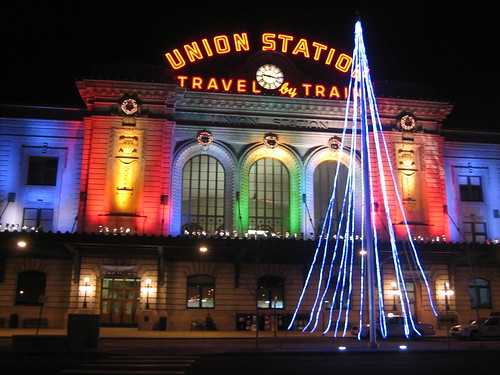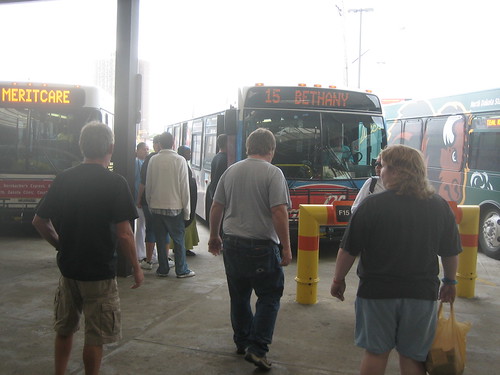
I arrived back in Cedar Rapids this afternoon (Tuesday) after riding the Amtrak California Zephyr overnight from Denver to Mt. Pleasant, about an hour south of CR. The train was already running about three hours behind early on Monday when I checked the train status online. Scheduled to depart Denver at 8:10pm, the adjusted time was about 10:30. Around 10:15pm, the train had arrived and conductors began checking tickets and issuing boarding passes. Then we waited, and waited, and waited. Almost an hour went by before we boarded, as they were having some trouble adding an addition coach car to the train. Unfortunately no formal announcement was made concerning the issue, so the 50 plus passengers waiting to get on were unaware of the cause of delay.
When I finally boarded I got on car 611, second from last and went on upstairs to find a seat. I didn’t see any empty row so I took a seat near the middle of the train by the stairs, next to a man who had been riding since Saturday all the way from Seattle, heading home to Kentucky. Not sure why he was on the California Zephyr (he must’ve gone from Seattle down to California, then eastward on the Zephyr), when the Empire Builder is much more direct to Chicago going through Montana, North Dakota, and down through Minnesota and Wisconsin.
The train began moving by about 11:30, and I soon made my way two cars ahead to the lounge. At this point the upper observation level was pretty empty and the cafe on the lower level was closed until morning. The lounge car was peaceful and more comfortable than crowded coach. I also planned to watch some movies on my iPod and did not want to disturb my elder seat mate.
Heading out of Denver, eastbound, the train goes through rail yards and passes mostly industrial sites in Commerce City. The TAXI redevelopment caught my eye in particular, which Will Bruder discussed in his keynote speech last Wednesday at FORUM. The eastern gateway into Denver via rail is not particularly inviting, but most aren’t. Denver Union Station is impressive, though, providing a grand gateway right in to the heart of downtown. The interior is large, but pretty plain and outdated. The elegant exterior is more dramatic at night with the charming “Travel by Train” neon sign and colorful spotlights on the building’s stone walls.
Denver plans to turn Union Station into the city’s prime intermodal transportation center, centralizing Amtrak, SkiTrain, intercity buses, RTD transit bus and light rail. This is already in progress with the C and E light rail lines terminus, endpoint for the Free Mall Ride shuttle, and several RTD bus routes. When completed it should be quite the place.
I woke up this morning around 7am, from the breakfast announcement. The northern sky to my left was a dim, gray blue, and a warm yellow glow from the sunrise to my right. It’s a pleasing view to wake up to – if you were able to fall asleep in the first place. I eventually went to the lounge car and had a hot breakfast sandwich. After reaching Lincoln and Omaha, a number of seats opened up so I moved across the aisle to two opens seats and was able to sleep for a few more hours.
I arrived at my destination, Mt. Pleasant, Iowa, around 4pm, just about five hours late. An announcement had been made earlier by the conductor that nearly all connections would be missed in Chicago, and emphasized our safety was their top priority. He asked us to, “Sit back, relax, and enjoy our train trip through the breadbasket of America” – how cute.
Overall I was satisfied with my experience this time on Amtrak, but then again I was anticipating delay and understand their current situation. The consistent issue of lateness on certain Amtrak routes is somewhat out of their control. The majority of trains, especially cross-country ones like the California Zephyr, operate on track owned by freight railroads, whose operations get priority over Amtrak. As far as service, all train attendants were generally pleasant and tried to keep passengers happy considering the significant delay. In today’s case, they were offering a complementary meal in the afternoon (served after I deboarded), but I was able to benefit from a complimentary snack just before reaching Mt. Pleasant.
I have ridden Amtrak in the past, mostly on the California Zephyr, but also once on the Three Rivers (now defunct I believe) to Pennsylvania, and one short trip on the Empire Builder from LaCrosse to Fargo. It is quite obvious Amtrak service has gone downhill over the years. It is not terrible, but there are a lot of band-aids, it is merely getting by.
Passenger rail service is a critical part of our nation’s transportation system and needs to be reinvested in and expanded. Amtrak provides transportation access to numerous small communities that may be hours from a commercial airport. Train travel is also much more efficient and more affordable than flying. While cross-country train travel is no longer practical for most people, it makes a lot of sense regionally between distances about 500 miles or less. Not only is it easier and less stressful than flying, rail typically takes passengers right into the center of cities, unlike airports that tend to be located miles away from downtown.

Several states, such as Illinois and California have partnered with Amtrak to expand passenger rail service. Regional associations have been established to promote regional high speed rail networks around the country. The Midwest High Speed Rail Association, which includes Iowa, promotes an expanded regional network originating from Chicago and providing more frequent service to more locations throughout the midwest. The proposal includes a new line that would run through the Quad Cities, Iowa City, and Des Moines, through to Omaha. A new line from Chicago to Dubuque is currently the most promising for Iowa in the works right now.
Amtrak and passenger rail service deserves much needed investment and support from the federal level. It is a matter of national security, sustainability, and accessibility. It is my hope that we will see much greater support for Amtrak and alternative transportation from the new Obama administration.







